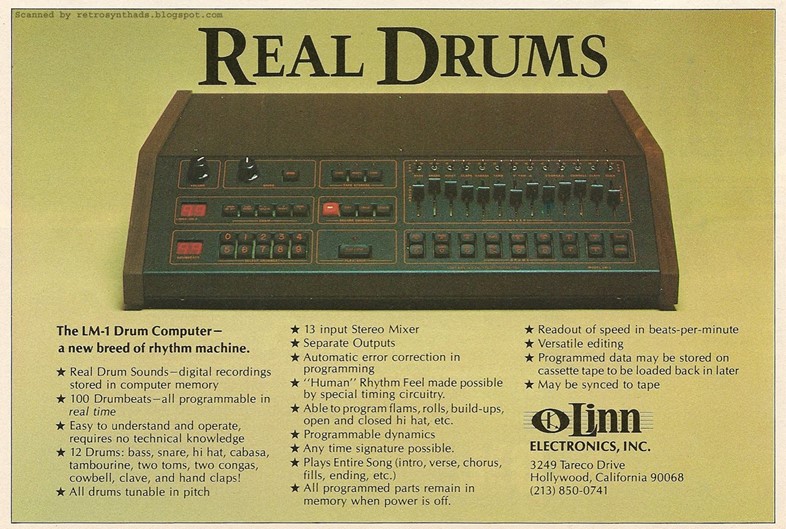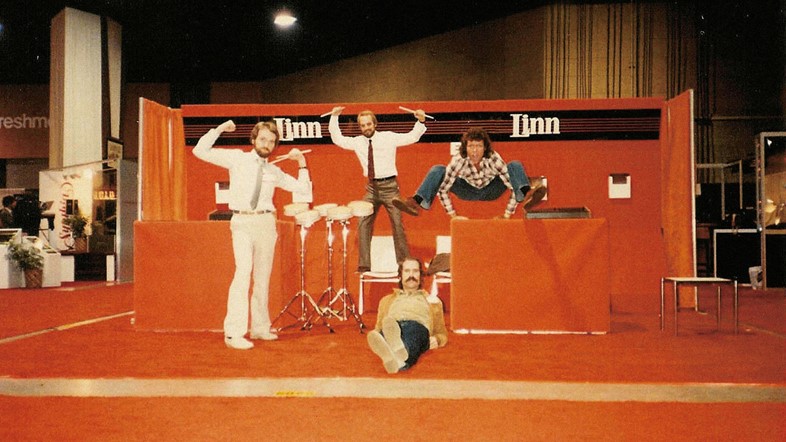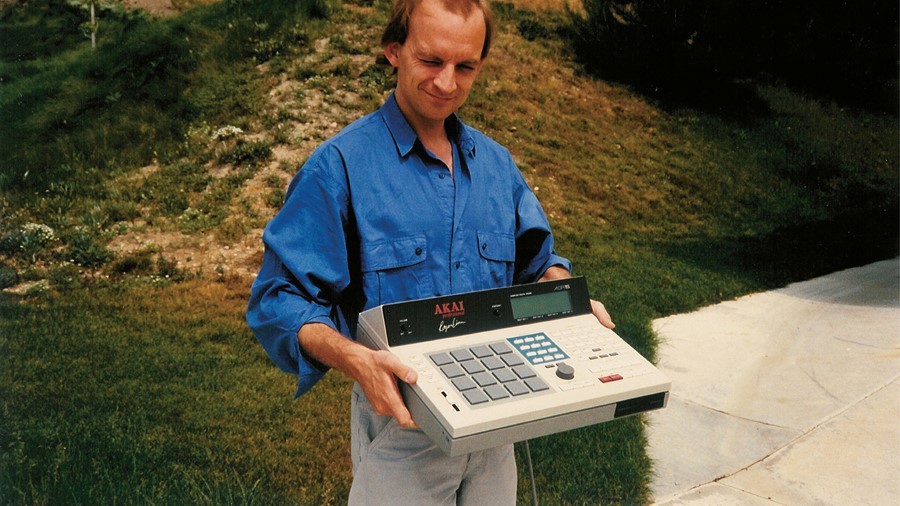Taken from the April 2006 issue of Dazed:
Every Monday night, Roger Linn drives from his house in the north Berkeley Hills down to the Gaffe Trieste coffee shop to soothe its patrons with mandolin renditions of traditional Neapolitan songs. When the weather's good, he even invites people up to his house to listen to jazz and world music. So it comes as somewhat of a surprise to hear that RZA, one of hip hop's most illustrious producers, regards the unassuming mandolin player as one of "the true foundations of hip hop."
Linn, you see, isn't only a mandolin virtuoso. That's just his hobby. What he's really known for is inventing the world's first programmable, digital drum machine. Without him, artists like Brian Eno, Prince, Dr Dre and Kanye West would have found it a lot harder to push back the boundaries of popular music. Yet somewhat ironically, Linn's legacy stems not from an infatuation with beats, but from guitars.
The son of an opera singer and a music professor, Linn took up classical guitar as a child but soon got distracted by the rock'n'roll revolution. Combining his passion for guitars and technology, the 14-year-old Linn took an afterschool job at a guitar shop in Hollywood, where he learnt how to install pick-ups. A few years passed, by which stage he had gained a reputation for fusing together existing guitar effects pedals to produce unique sounds. Fanny, an all-girl underground rock group, bought his first product – a customised distortion pedal.
"They were happy with the sound but at that stage, I hadn't learnt how to make things reliably," Linn recalls some 35 years later. "I later heard that they regularly intercepted baseball commentary at their gigs!"
By the time he turned 20, the Mini Moog synthesiser had started to infiltrate rock, and Linn got a gig playing guitar and programming synths for Leon Russell, the session player who had arranged Ike & Tina Turner's "River Deep, Mountain High" before becoming a solo star.
Then in 1977, Linn heard about the invention of personal computers, a development that spurred him on to form his own company, Linn Electronics.
"A friend of mine took me to The Computer Store, which was the only place in Los Angeles that sold them. It was run by these proto-typical nerds who used words like bits and bytes, megahertz and gigahertz. I was intrigued. Then another shop popped up into existence near me, so I bought one for $3,000. I was convinced that there was art inside that box and I was the one that had to pull it out. It was on that computer that I wrote my first drum machine programme."
Basic analogue drum machines such as Ikutaro Kakehashi's FR1 Rhythm Ace were already being produced, but they lacked authentic drum sounds and forced users to rely on 16 preset drum patterns – great for bossa nova organ solos, but not so cool to rock out to. "Leon used these cheap drum machines to help him overdub," the 50-year-old recalls.
"If you record a track with a bad drummer and his timing is off, then the drummer who comes in to overdub his part is going to have to match the wavering tempo. He used to say 'I wish I could change the beat to have the bass drum here or the snare drum here.' I'm sure that lots of people thought that would be a great idea, it's just that nobody else decided to make it!"
“Watching Stevie, a sightless man, it occurred to me that a screen grid was not as intuitive for musicians. It needed to be something with more audible feedback, so I went back to the drawing board" – Roger Linn
Using an existing Roland soundboard, Linn designed a rudimentary computer interface a visual grid that triggered drum sounds at predetermined points of a song. He demoed a prototype for Stevie Wonder. "Watching Stevie, a sightless man, it occurred to me that a screen grid was not as intuitive for musicians," Linn remembers. "It needed to be something with more audible feedback that you could use in real time, so I went back to the drawing board. In doing so, I accidentally created the concepts of quantize and swing, a feature that effectively corrects human timing errors."
Linn's other key innovation was the introduction of sampled drum sounds. He knew about digital recording, and figured that the answer was to store digital recordings of drum sounds on computer memory. Although memory was prohibitively expensive, the storage for only a handful of single drum strikes would be affordable, just. Drummer Art Wood came to his house and recorded various percussive hits, which Linn mapped into the system. Eventually, in 1979, the revolutionary Linn LM-1 digital drum sampling machine was announced, and began shipping the year after with 12 sounds and a price tag of $5,000.

"I would ask for a 50 per cent deposit from people like Stevie and Herbie Hancock," he says. "It's amazing that they just put down deposits on faith. All they'd seen was a prototype with wires hanging out of a cardboard box."
News of a machine that sounded "like a real drummer" soon spread, and chart hits featuring the LM-1, such as Hancock's "Rockit", "Don't You Want Me Baby" by The Human League and Prince's "When Doves Cry" started to appear. A few months later, Roland unleashed the TR-808, a cheaper analogue drum machine that, thanks to its booming bass kick and cutting snare, would go on to become synonymous with dance music. Yet Linn maintained his own course and developed an improved model called the Linn Drum, followed by the Linn 9000 - an 8-bit drum machine (think early computer game soundtracks) that had the ability to sample outside sources. However, a few months after its 1986 release, Linn's business inexperience led to the closure of his company, which, by then, had 50 staff.
But he wasn't out of the race for long. A new company called Akai had entered the electronic music world with a range of 16-bit digital samplers. They hired the 31-year-old to modify the Linn 9000 to compete against drum samplers such as EMU's SP12, which was already the weapon of choice for hip hop producers such as Public Enemy's The Bomb Squad and Marley Marl.
In 1988, Akai launched the MPC 60 a square drum machine with 16 large rubber pads, which could sample 26 seconds worth of audio. It effectively gave the producer the means to make beats, sequence instruments and sample new sounds all in the one machine.

"I had noticed that people were starting to sample big chunks of other people's records," the inventor says. "I thought it was odd that they were using a machine that should be used for drums and just looping a segment, you know, basically standing on the shoulders of giants. Instead of creating every note, they took all these little snippets and arranged them in provocative new ways."
Over the next few years, hip hop artists like A Tribe Called Quest, De La Soul, The Pharcyde and Gang Starr traded in their SP12s and moved up to the MPC 60 in an attempt to make their music more than just loops. Unfortunately, Akai's sales didn't immediately reflect this trend, and they let Linn go. It was a bad move. As hip hop and dance continued their cultural ascendancy, the MPC lent its distinct human "groove" to more chart hits. Realising that they had made a mistake, Akai persuaded Linn to come back to design a more powerful MPC.
“I still think it's funny that I'm considered to be so responsible for hip hop, as I don't know it at all! I prefer gypsy jazz” – Roger Linn
In 1994, they launched the MPC 3000, a machine that basically doubled the power of the 60 by adding more memory, sample space and effects. Hooked by its looks and features, Dr Dre, The Chemical Brothers, Jay Dee and DJ Shadow each bought one and began pushing it to its limits, resulting in some of the most progressive albums of the last few decades. "If there’s ever a hip hop hall of fame Roger Linn has to be inducted within the first year," says Wu-Tang's RZA. "He’s like the motherfucker who made the piano. He’s a genius that should never stop getting props. It’s like how Grandmaster Flash came with the scratch – these guys are the true foundation of our culture. Even to this day 80% of hip hop is produced on that machine.”
In his typical understated fashion, Linn is reluctant to cash in on his b-boy VIP status. "I'm embarrassed to say it, but when hip hop and dance came along my tastes were leaning in a different direction," he says, almost apologetically. "I still think it's funny that I'm considered to be so responsible for hip hop because I don't know it at all! These days I don't really listen to music with drum beats. I prefer gypsy jazz."
After another communication breakdown at Akai, Linn left for good and set up Roger Linn Design, a company dedicated to inventing and developing guitar technology, which he still runs today. Akai went on to make more advanced models of the MPC, and in late 2004, the company was bought by Jack O'Donnell, the owner of Numark and Alesis, who stopped the inventor's royalty payments.
While thousands of beatmakers can still be found hunched over their beat generators, hoping to pull some magic out of them, many see the age of the MPC coming to an end with the advance of cheaper and more sophisticated computer software. Whatever happens next, Linn's role in the evolution of digital music remains unquestioned.
"It's great that people still use my machines," Linn modestly concludes. "But I'm just one of many innovators. All I did was invent a better brush for the painters, that's all."
ROGER LINN: HIP-HOP MVP
Tracing its influence from the 80s to the present day, four hip hop producers assess the impact of Linn’s MPC on their career
DJ PREMIER
Producer for Gang Starr, Nas, Jay Z, Notorious B.I.G, Jeru The Damaja and Group Home.
“After making the first Gang Starr album on an SP 12 I ended up buying a used MPC 60, and have stuck with it ever since. Some people listen to music but they don’t give a fuck about the drum machine or the equipment. I do. If someone was to introduce me to Roger Linn I’d be like “Oh shit! You the man, you the truth! We turned your invention into a funky beat machine!’”
PETE ROCK
Solo artist and producer for CL Smooth, Nas, Public Enemy and Run DMC.
“I don’t know what the fuck Roger Linn was thinking about but he hit it right on the button with that machine man! For his drum machine to even connect with black music is a major achievement all of its own. I mean he’s a rock n’ roll guy and we’re soul men, and we still made it work for us. We turned it black. I’m pretty sure a lot of other DJ’s and producers are happy Roger Linn did his thing.”
DJ SHADOW
Solo artist and producer for UNKLE, Solesides, Cage and Paris.
“When I got it home I remember thinking ‘I can’t believe I actually own an MPC!’ That night I stayed up till 5 in the morning just figuring out how to use it. I had this feverish anticipation of how I could start making my ideas come to life. After Entroducing came out a lot of people started coming up to me with questions about it like ‘How did you manage to chop that beat up like that?’ It showed me that people were really listening to the production of my records.”
RJD2
Solo artist and producer for Aceyalone, Copyright, Diverse and Blueprint.
“Since I got my MPC 2000 in 1997 I’ve made all of my beats on it. It’s the best machine that’s out there. I love all of the bizarre nuances it’s capable of. It’s like having a girlfriend – they have all these attributes that are so cool but if you press the wrong button it freaks them out. Well, the MPC is exactly the same. Kind of.”


